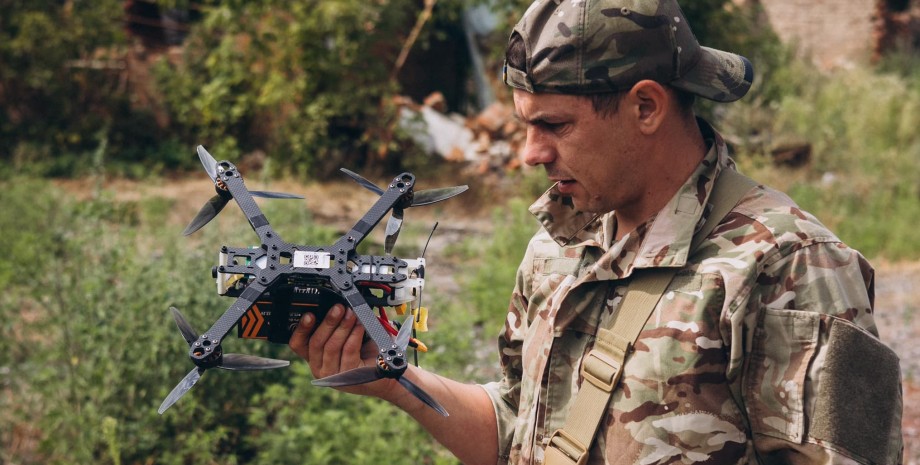
 By Victor Duda
By Victor Duda
Thanks to these systems, Ukrainian soldiers effectively destroy tanks and knock down planes. Russian units, as noted, are under constant supervision, and their communication lines are prone to failures by the enemy - as well as Ukrainian. Both states are in a hurry to develop even more advanced technologies that can withstand ruthless attacks and overcome the enemy's defense, the publication notes.
However, the war in Ukraine is not the only conflict in which new technologies change the nature of hostilities. In Myanmar and Sudan, both rebels and the government use unmanned aircraft and algorithms in their fighting. In 2020, an autonomous drone of Turkish production, deployed by the troops supported by the Libya government, struck the combos who retreat - perhaps it was the first attack of drones, conducted without human participation.
In the same year, Azerbaijan's military was used by Turkish and Israeli -made drones, as well as ammunition, who are barring to capture a disputed Karabakh enclave. And in the Gaza Sector, Israel placed thousands of drones connected to the AI algorithms, helping the Israeli troops to navigate the city canyons of this territory, reminded in the publication. In some sense, there is nothing surprising at the pace of such developments. The war has always been innovated.
But today's shifts are extremely fast, and they will have a much greater effect. Future wars will no longer depend on someone who can gather more people or expose the best planes, ships and tanks. Instead, they will be dominated by more autonomous weapons and powerful algorithms. However, unfortunately, this is the future to which the United States remains unprepared, ascertaining in Foreign Affairs.
Their troops are not fully ready to fight in an environment in which they rarely use an element of surprise. Their planes, ships and tanks are not equipped to protect against the pressure of drones. The military has not yet accepted artificial intelligence. The Pentagon does not have enough initiatives aimed at correcting these failures, and his current efforts are being promoted too slowly. Meanwhile, the Russian military has placed many drones in Ukraine with artificial intelligence.
And in April, China announced its largest military restructuring for almost decades with a new focus on the increase of technologically sound forces. And if the US wants to remain a leading world state, they will have to change the course quickly, the authors of the publication say. The country needs to reform the structure of their armed forces. The US military needs new ways of purchasing equipment. They need to buy new types of equipment. And they need to better teach drones and use the AIs.
It was often difficult for military analysts to predict what innovations would determine future battles. But today it is easier to make forecasts. The drones are ubiquitous, and the work is increasingly used. Fighting in Gas and Ukraine showed that artificial intelligence is already changing ways of war. The next major conflict is likely to lead to the total integration of the AI into all aspects of military planning and implementation.
For example, AI systems can model different tactical and operational approaches, which will significantly reduce the period between preparation and execution. The Chinese military has already created the commander of the AI who has the highest power in large -scale virtual military games. Although Beijing forbids the AI systems to make a choice in real situations, he can draw conclusions from his numerous virtual simulations and convey them to the decisions.
And China can eventually give the models the right to make the choice, as well as other states. Ukraine, as noted, has already tried to convey as much dangerous tasks as possible to the forefront to maintain scarce labor. Until now, automation has been focused on naval power and aviation in the form of marine and air drones. But soon it will switch to a land war.
In the future, the first phase of any war is likely to be headed by ground work, capable of everything: from intelligence to direct attacks. Russia has already launched unmanned land vehicles that can launch anti -tank missiles, grenades and drones. Ukraine used robots to evacuate the wounded and dispose of explosives. The next generation of machines will be headed by artificial intelligence systems that use robot sensors to map the battlefield and forecast attack points.
Even when soldiers-people eventually intervene, they will be headed by air drones with a first-person view that can help identify the enemy, as is already in Ukraine. They will rely on machines for clearing mine fields, absorption of the first volleys of the enemy and detecting a hidden enemy.
And if the war of Russia after Ukraine extends to other parts of Europe, the first wave of land robots and air drones can allow both NATO and the Russian Federation to control the wider line of the front than those that people can attack or protect alone. Automation of war can be necessary to save the lives of civilians. Historically, wars were waged and won in open areas where few people live.
But as global urbanization attracts more and more people in the cities, and non -state entities switch to the tactics of the city guerrilla warfare, the decisive fields of fighting the future are likely to become densely populated areas. Such fights are much deadly and require much more resources. Therefore, they will need even more robotic weapons.
The military will have to be placed on the streets of small maneuverable robots (for example, robots) and fill the sky with unmanned aerial vehicles to take control of urban positions. They will be directed by algorithms that can process visual data and make decisions for a second. Israel helped to become a pioneer of such technology by applying the first real swarm of drones in Gas 2021.
These individual drones bypassed Hamas's defense and contacted a Wi -based weapon system to make collective decisions on where they should go. The use of unmanned weapons is necessary for another reason: it is cheap. Reduilders are a much more accessible class of weapons than traditional military aircraft. For example, the MQ-9 Reaper drone costs about four than the F-35 fighter. And MQ-9 is one of the most expensive types of such weapons; Simple FPV-Dron can cost only $ 500.
A team of ten such drones can immobilize a $ 10 million tank. Such accessibility could allow the States to send switches - some of them are intended for observation, others for attack - without worrying about exhaustion. These swings could suppress outdated air defense systems that are not intended for the simultaneous knocking of hundreds of objects. Even when defense systems prevail, the cost of protection against swarms will far exceed the cost of attack for the enemy.
Iran's massacre on Israel using drones and rockets in April cost him a maximum of $ 100 million, but the US and Israel's efforts cost more than $ 2 billion. No state is ready for the wars of the future completely. No country has started to produce the necessary equipment for a large scale robotal weapon, and no state has created the software required for full power of automated weapons. However, some countries have advanced further.
And, as noted in the publication, opponents of the United States are leading in many ways. For example, Russia, having gained experience in Ukraine, has dramatically increased the production of drones and now uses them to achieve great effect on the battlefield. When it comes to AI, the United States has the highest quality systems and spend the most, but China and Russia are rapidly gaining momentum.
Washington has resources to continue to spend more, but even if he retains this leadership, it can be difficult to overcome bureaucratic and industrial obstacles to the deployment of his inventions in the battlefield. The US military is at risk of war in which their first -class training and excellent ordinary weapons will be less effective. For example, US troops were not fully prepared to act on the battlefield, where each step can be noticed and where they can quickly attack drowning drowning.
The United States will also be vulnerable at the sea. Chinese hypersonic missiles can sink American aircraft carriers before they leave Pearl Harbor. Beijing is already unfolding systems for artificial intelligence, which can give him a defensive advantage over the United States throughout the Indo-Pacific. In the air, an effective but expensive F-35 may encounter swarms of cheap drones. The same can be done by heavy -armed Abrams and Bradley tanks on Earth.
In view of these sad facts, US military analysts have come to the conclusion that the era of shock and thrill campaigns, in which Washington could destroy their opponents with the overwhelming fiery power, ended. In order not to become outdated, large reforms need to be carried out by the US military by reviewing the processes of software and weapons. The current procurement process is too bureaucratic, is not at risk and is slowly adapting to the rapidly developing future threats.
The United States should seek to buy a weapon from a wider circle of companies than usual. In 2022, Lockheed Martin, RTX, General Dynamics, Boeing and Northrop Grumman received more than 30 percent of all money under the Ministry of Defense Contracts. New manufacturers, on the contrary, have received almost nothing. Less than one percent of all contracts of the Ministry of Defense went to venture capital companies, which are usually more innovative than their larger colleagues.
These interest should be much more equal. The next generation of small cheap drones is unlikely to be developed by traditional defense firms that are interested in the production of fashionable but expensive equipment. They are likely to be created as it was in Ukraine: because of a government initiative that supports dozens of small startups. However, to adapt to the future United States, you will need to do more than just reforming the method of purchasing weapons.
They should also change the organizational structure and system of army training. They should make their complex hierarchical command chain more flexible and give more autonomy small, high -mobile units. These units should have trained and authorized to make important leaders' fighting decisions. Such units will be more flexible - an important advantage given the rapid pace of war using AI. "War is disgusting, cruelly and often for too long.










All rights reserved IN-Ukraine.info - 2022